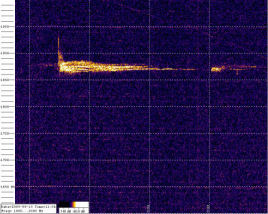
Forward Scatter Observations of the Perseids Meteor Shower 2005

Introduction:
Meteor showers owe their names to the point in the celestial sphere from where
they seem to emanate. This point is known as the Radiant so most showers are
named after the constellations in which the Radiant is located.
One of the most prominent showers of the year is the Perseids which start around
25 July to 20 August, maximum being about 12 August. Their Radian lies within
the constellation of Perseus (The Greek hero who saved Andromeda from Cetus
the sea monster) The Perseid shower normally provides fast moving meteors with
persistent trains and if the conditions are right can give a brilliant visual
display. These meteors are normally leaving trails at a rather narrow altitude
band of between approximately 85km and 105km.
Detecting meteors using radio normally employs either Back-Scatter or Forward-Scatter
of radio waves reflected off the meteors ionised plasma trail. Back Scatter
(fig 1. St A to St B) is one of the commonest methods used by professionals
to collect data on meteors, because this method uses a transmitter to reflect
the stations signal back to its location these stations are sometimes called
“meteor radar”. Amateurs as well use
Back-scatter to work stations on wavelengths and modes that under normal conditions
would not be received at such close range to the transmitting station.
Back-scatter requires the transmitted signal to strike the Meteors ionised plasma
trail at an angle that reflects the signal back to or near the transmitting
station. This method allows astronomers to study meteors in greater detail based
on size, velocity, direction and angle of entry into the earth’s atmosphere.
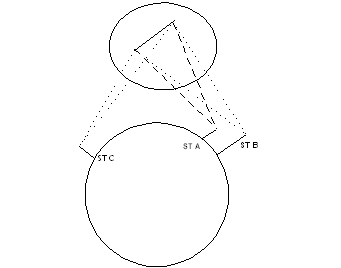 Fig1
Fig1
St A = Transmitter St B = Meteor Radar Receiver St C = Forward Scatter Receiver
T = tangent Plane. Meteor moving in at steep angle less effect at ST C.
Forward-scatter
(and I include side-scatter as for all intents and purposes the data is undistinguishable
using my equipment) can also be used by professionals and amateurs to transmit
short bursts of information and can even be used as a backup to satellites.
The main difference being to increase range by reflecting the signals forward
away from the transmitting station (Fig1 St A to St C).
The advantage for the meteor observer is that any conveniently located transmitter
on the right frequencies, even if not being used for meteor detection, can be
utilised. I prefer to use TV carriers and use USB (Upper Side Band) as this
gives me a narrow yet strong signal, which I then tune about 100khz away from.
It is possible to find listings for frequencies on the web.
Equipment:
The equipment I use is a communications receiver (Fig 2), one that covers 30mhz
to 300mhz and operates in USB, FM and AM modes, with an external speaker or
Aux output. The antenna I use is a discone type that covers the bands that the
receiver uses; this is omni-directional unlike if you were to use a Yagi type
antenna. A PC with a sound card, most any will do, and a Audio Spectrum Analyzer
program; these can be found on the web there are quite a few good ones around
freeware. A lead to connect the receiver to the sound card in the PC and an
atlas; this is to find the locations of the transmitting stations.
 (Fig2)
(Fig2)
Method:
The Perseus lies to the north almost opposite to Ursa Major with Polaris between
them. From my location that puts any north European stations in a good position.
This is because the mean altitude of most trails is at approximately 95km. So
for the meteor to create the forward scatter it must lie within a plane, which
is a tangent to an ellipsoid, which has the transmitter and receiver as its
foci. This plane is called the “Tangent plane” figures 1,3,4 show
this and also that the transmitter is located beyond the reception of the ground
wave. As it is the sky wave being reflected forward from the ionised trails
that we wish to receive; and the Doppler effects as the ionised cloud of plasma
is manipulated by the combinations of high ionosphere winds and the density,
speed and mass of the meteor. The meteors position within the plane can also
greatly affect the duration of the event as well as the distance between the
transmitter and receiver locations. Meteors occurring at the centre of, or just
off centre of the Tangent plane; can give many times the duration of echo (10
to 90 times) against meteors arriving at the extreme edges of the tangent plane;
also dependant on the baseline off the two stations being worked.
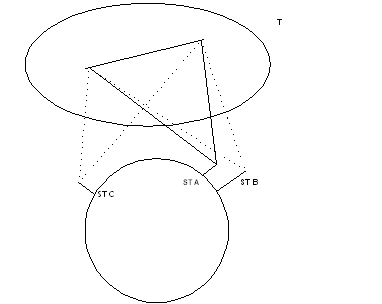 Fig3
Fig3
St A = Transmitter St B = Meteor Radar Receiver St C = Forward Scatter Receiver
T = tangent Plane. Meteor moving in at less steep angle increasing duration
of affects
at St C.
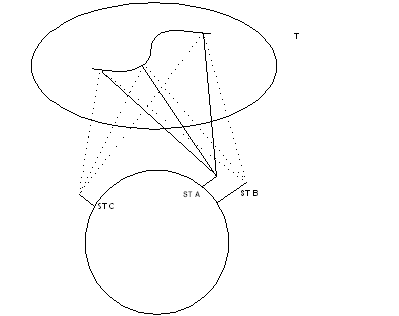 Fig4
Fig4
St A = Transmitter St B = Meteor Radar Receiver St C = Forward Scatter Receiver
T = tangent Plane. Meteor trail affected by high altitude winds varying reflection
affects at St C.
Data:
Using the software to show the spectrum of the audio signal allows for the display
of the frequency shift in relation to velocity of the meteor. The program creates
a “Waterfall display, allowing the representation of the intensity of
the signal by colour, the velocity by the increase or decrease in frequency
Y – axis and time by the X – axis. The better programs allow for
a screen shot to be automatically saved at set intervals. Therefore you can
store completed runs for later analysis.
The resultant Meteorgrams (Fig5) show some interesting observations. An increase
in the number of meteors as the earth rotates into the oncoming path of the
shower in the early hours and mornings.
The short but wider bandwidth signal as the meteor enters the ionosphere at
velocities of 11km/s to 72km/s.
Then the much slower moving ionised plasma, which is affected by the winds in
the ionosphere.
Sometimes you may seem to get combinations maybe when a larger object breaks
up after its initial contact releasing more material and forming secondary trails
or it could be the effects of layering in the high atmospheric winds?
One interesting object, which is increasingly disruptive to visual observers,
is aircraft and these aluminium tubes with wings give a very distinct pattern
(Fig5a.
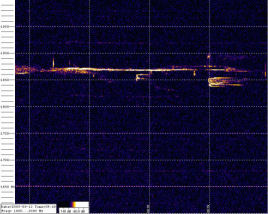 Fig5
Fig5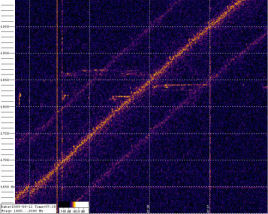 Fig5a
Fig5a